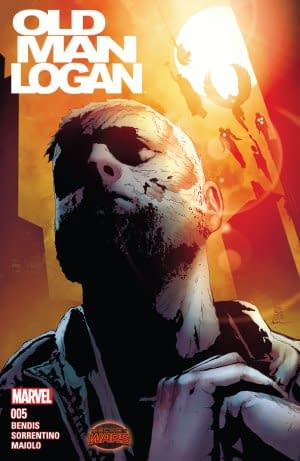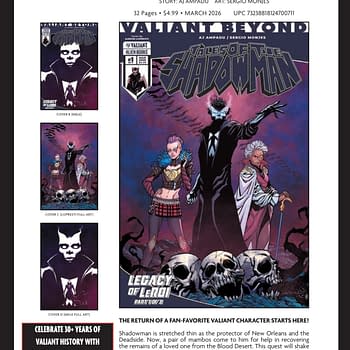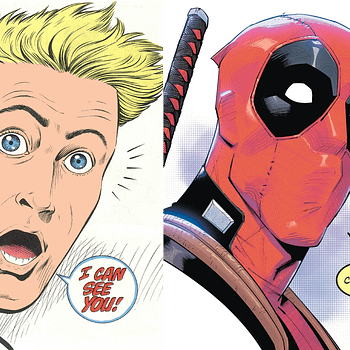Posted in: Comics | Tagged: agents of shield, Comics, entertainment, image comics, Jessica Jones, Marvel Comics, paper girls
Thor's Comic Review Column – Paper Girls #1, Marvel Superhero Contest Of Champions, Archie #3, Jughead #1, Secret Wars #6, Secret Wars: Siege #4, Secret Wars: Old Man Logan #5, Marvel's Jessica Jones #1, Avengers #0
THIS WEEK'S REVIEWS:
Paper Girls #1
Marvel Super Hero Contest of Champions TP vol. 1
Archie #3
Jughead #1
Secret Wars #6
Secret Wars: Siege #4
Secret Wars: Old Man Logan #5
Marvel's Jessica Jones #1
Avengers #0
Paper Girls #1 (Image Comics, $3.99)
By Devon Sanders (@devonsanders)
Paper Girls #1 is a very special comic.

There is no spandex here. Just four young girls and a creative team's understanding of a shifting comics demographic that asks for more in their entertainment.
In this Vaughan/Chiang partnership, this idea is stewarded along with the care and bravery it deserves.
1988 and it's the day after Halloween in a small suburb of Cleveland and Erin wakes from a bad dream. She shakes it off and begins her first day on the job. She expects nothing but the opportunity to do her job. That idea is soon broken up by the thing that pulls dread most into the heart of anyone trying to get anything done: teenaged boys. Post-Halloween, they howl and they threaten and are soon met with the one thing they're most afraid of: strength in numbers. Enter the Paper Girls, KJ, Mac and Tiffany and they are not having it. The boys skulk away and the girls reconvene into what they think will be just another day. They all, somehow, missed the flash of light in that early morning sky and the incredible thing it will bring before them: the future.
From page one, writer Brian K. Vaughan had me. On the final page, he killed me. Vaughan perfectly captures the feel of the 80's in his dialogue, characters use words we don't quite know yet not to use. Interaction is the default and the future is a thing very far away.There's a sense of being stuck here; of being in-between something but not knowing quite why you feel that way. The true glee in this that the characters just don't know how soon this world will change and don't know just how much they could potentially contribute to its coming about. Under Vaughan, that ignorance masterfully feels like their last, true blessing.
What can I say about Cliff Chiang's art? Paper Girls feels like the comic I didn't know I wanted from Cliff Chiang. Rockets from outer space, frantic suburban bike rides, chain smoking teens, looks of absolute wonder and befuddlement. It's all here and builds into something more phenomenal with every turn of the page. Chiang has quietly become one of comics' most gifted storytellers and years into this, Paper Girls is his "Allow me to re-introduce myself, My name is Hov" moment. He's got me throwing up the Chiang sign.
Paper Girls #1 is smart, surprising and full of possibility. It is simply what happens when some of comics' best minds converge on a great idea and I am happy to be a witness.
Devon Sanders wants you to know that he's still here.
Marvel Super Hero Contest of Champions TP vol. 1 (Marvel, $7.99)
By Cat Taylor

As Tom DeFalco's editorial at the end of this collection explains, the Contest of Champions limited series was originally meant to be a Marvel Treasury Edition tie-in to the 1979 Olympics but wasn't published at the time due to the United States pulling out of the games. Due to the Olympic tie-in, Marvel also used the opportunity to introduce a number of brand new non-American heroes. However, despite any future hopes for the new characters, none of them ever reached higher than the C-list within the Marvel pantheon.
Getting Contest of Champions off the ground was apparently a pretty cumbersome task, and involved the combined writing talents of Bill Mantlo, Mark Gruenwald, and Steven Grant. Also, by the time the series finally saw publication, it had to go through some major revisions, courtesy of Bob Layton primarily, to get the depicted characters and events updated to the 1982 status of the Marvel Universe. Layton's work on the series mainly involved him updating the appearances of many of the characters as originally penciled by John Romita, Jr. and inked by Pablo Marcos. While there is much to question regarding the story itself, the combined talents of these artists produced classic 1980s' Marvel-style visuals that still stand up to this day. Classic Marvel artwork aside, the number of blatant mistakes that made it to print coupled with the general nature of comic-book stories in 1982, make the original Contest of Champions as entertaining today as the series was to me back then although for very different reasons. In fact re-reading and spotting all the mistakes and general plot holes made me think that a lot of readers must have walked away with a ton of Marvel's coveted "No-Prizes" that used to be awarded to those who spotted and explained away their errors and inconsistencies. So, just for fun, I thought I would do something a little different with this "review" and list all the errors, plot-holes, inconsistencies, and generally perplexing story elements I noticed below.
So, the **SPOILER ALERT begins now:
The opening shot of the Avengers training in their mansion is loaded with goofy dialogue that gives clumsy exposition as the characters explain exactly what you see them doing. This scene is also used to force the characters to state the names of everyone else in the room. I didn't notice any actual mistakes in the scene but it sure comes off as awkwardly forced and tremendously corny.
The above scene also leads to a game where the Beast says he can avoid being caught by the other six Avengers for one-minute. The fact he eludes all of them for even thirty-seconds is incomprehensible considering that Iron Man is one of the other Avengers and he's capable of flying into outer-space and back at speeds faster than a military fighter jet.
To get every hero in the world together for the "Contest of Champions" the Grandmaster and the Unknown simply teleport everyone there. Bam! No explanation, just a Deus ex Machina that they can apparently do whenever they want. It was pretty obvious the writers didn't want to waste time for background or set-up. "Let's just get straight to the point!" Actually, that could be seen as a strength of the story.
Once the heroes are gathered and the rules of the contest are explained, the Grandmaster tells the heroes that in order for neither side to have an unfair advantage, only homo-sapiens can be used in the contest. That means no gods, aliens, Inhumans, Eternals, Atlanteans, etc. Okay, so why even bring all of those disqualified individuals to the gathering in the first place? Also, how does being of an offshoot humanoid species necessarily give someone an unfair advantage? By that logic, Medusa has an advantage over Ms. Marvel, and Balder the Brave would be more powerful than Hulk. In addition to that, for some reason, mutants (homo-superior) were not disqualified and were used in the Contest. In fact, the selection of participants for each team seemed incredibly random. For instance, in a contest where the goal was to be the first to find and retrieve a hidden prize, Defensor was picked but not Dr. Strange. Angel was chosen but not Quicksilver, etc.
The assembled heroes were told that if they refused to play the game, the Earth would remain in suspended animation for eternity, but if they played and Grandmaster's team won, he would never use Earthlings in his schemes again. If they played and the Unknown's team won, the life of the planet Earth would be extended another few thousand years. Well, what if one of the Grandmaster's team thought extra life for the Earth was more important than not being used in the Grandmaster's schemes? Couldn't he or she just pretend to be trying but intentionally throw the contest to the other team?
The Unknown refers to the 24 heroes selected as "two score." She may be an all-powerful entity, but she sucks at math.
Le Peregrine uses a diving dropkick but calls it a savatte-kick.
Captain America refers to a giant red snake a "python."
There is some comically outdated slang that would never pass the PC standards of today, such as Wolverine calling a person from France a "frog" and Black Panther being referred to as "Blacky."
Speaking of Black Panther, the flesh around his eyes is Caucasian-colored.
Speaking of Wolverine, he gets called "Shorty" but he's drawn taller than, or as tall as, the other characters around him.
Speaking of Wolverine again, he actually tries to slice up Black Panther with his claws. When questioned why he would try to kill another hero for a game, he just says, "I play for keeps."
When the Collector is revived from the dead, he knows the details of what just happened in the game. How could he know what happened while he was dead?
Marvel attempted to catalog every single living super-hero at the time in a glossary in the back of each issue. However, they apparently realized they left a bunch of people out by the last issue. Instead of admitting it and doing a supplemental list, they forced the forgotten heroes into "other" categories such as "Heroes from other worlds", "Inactive Heroes," and "Quasi-Heroes." Many of those listed in those categories were clearly misclassified and should have been included in the main list.
The object of the contest was for each team to retrieve the four segments of a sphere that had been hidden across the world. Whichever team retrieved the greatest number of segments would be the winner. There was no explanation of what would happen if there had been a tie, and in fact…
The biggest blunder of them all was that Shamrock retrieved the final piece, thereby giving the win to the Grandmaster, but she was actually on the Unknown's team. So, the contest really ended in a tie but the writers goofed up and wrote it as Grandmaster's team winning. DeFalco discusses this in his editorial at the end of this collected edition. He writes about how much mail they received from fans pointing out their blunder and how he and Gruenwald were called into a furious Jim Shooter's office asking how they could have screwed up so badly and yet nobody who worked on the book noticed before it was published. According to DeFalco, Gruenwald claimed the error was intentionally done to set up for a sequel. Yet, it was pretty obvious to DeFalco and everyone else that the mistake wasn't at all deliberate, and that Gruenwald only said that to save his ass. Regardless, a sequel did finally appear in the annuals of Avengers and West Coast Avengers five years later! I guess that's only something like a year and a half in comic-book time though.
**END OF SPOILERS
All in all, despite the many blunders and plot-holes, it was fun re-reading this series in a different time and from a different perspective. On the positive side, what impressed me even more than how far comic-book storytelling has come since 1982, was how so many of the specific panels were burned into my memory from so long ago. Even seemingly insignificant images from Romita Jr.'s and Marcos's scenes were as fresh in my mind as the day I first saw them. Therefore, I have to admit that this series made a more positive than negative impression on me overall. While I won't deny that most of that is due to nostalgia and a new reader will likely be more frustrated by the bullet-points above, this series does represent three major milestones in comic books by being the first-ever limited series, the first time every Marvel hero was brought together into one story, and the first time every Marvel hero was catalogued into a dictionary-like reference list that was a predecessor to the later published Marvel Universe.
If you think you might be interested in picking this up, be warned that despite being advertised as "chock full of extras," the only extras actually included are some pages of "original" black-and-white art from the series, and DeFalco's editorial about the series which can also be found in the 1999 trade collection. In fact, if you can find the 1999 trade, you'll have a more complete experience because that collection also includes the 1987 Avengers and West Coast Avengers annuals that continued this story.
Cat Taylor has been reading comics since the 1970s. Some of his favorite writers are Alan Moore, Neil Gaiman, Peter Bagge, and Kurt Busiek. Prior to writing about comics, Taylor performed in punk rock bands and on the outlaw professional wrestling circuit. He just busted the zipper on his last good pair of slacks. Does anyone know how to fix a broken zipper? You can e-mail him at cizattaylor@hotmail.com.
Archie #3 (Archie Comics, $3.99)
Jughead #1 (Archie Comics, $3.99)
By Graig Kent

The new Archie #1 launched with a couple dozen variant covers and much fanfare. While no one was doubting the talent of writer Mark Waid and artist Fiona Staples, I think up to the release fans (current and lapsed) alike were extremely wary of what the end product would be like. It would have to be a radical reinvention of the Archie comic (otherwise what's the point) but would it still be recognizably Archie and would it be any good? The answer to both those questions was an emphatic"yes", and what's more, the title has gotten even better with each issue.
With this third issue, Waid and Staples bring Veronica Lodge into the Riverdale High fold and she makes an impact, on everyone, especially Archie. Jughead can smell the trouble wafting off of the new girl, and it smells like direly expensive perfume. He attempts to enlist Betty's help in steering Archie away, but she's trying to distance herself from her ex-boyfriend. It's not until the first meeting between Betty and Veronica — where charitable and good-hearted meets snobby and selfish — that Betty agrees something must be done.
The Archie characters largely have established traits and personalities, but reading almost any old Archie story they rarely feel like people. Waid manages to bring humanity to the Riverdale gang, though not exactly reality. It's a heightened existence that allows for the broad physical comedy that has always existed in Archie books to persist, as well as making these characters seem more iconic and larger than life without seeming out of place in their environment. In many ways this is the best dram-rom-com not on television, as Waid and Staples populate the world with a lot of attractive people (even Jughead's looking rather dashing in an Adam Driver sort of way) and give them punchy, clever dialogue, and amusing dramatic situations that engage and entertain, but also point to longer-term, ongoing storytelling.
The first meeting of fiction's most notorious frienemies had to be handled so specifically as to establish Betty and Veronica's animosity but also put in the foundation for friendship, and Waid and Staples do so brilliantly. They manage to make their rivalry about the characters and their clashing personalities, nothing whatsoever to do with Archie (historically their contention has largely been about their personality and class differences, but popular perception of them is two girls fighting over a boy). Beyond that, the issue is legitimately hilarious, an honest-to-gosh "funnybook".
The thing about Waid and Staples' Archie is it doesn't center itself exclusively on Archie. As the first book out the gate it has the task of establishing the "Archie Universe" (ergo, Riverdale) and defining its core cast. In the past there was no definitive Archie or Jughead or Betty or Veronica, so how would spinoff books, like the new Jughead series, fare? Much like how Scott Snyder and Greg Capullo's Batman provides the definitive Batman through-line for the New 52, the source from which all other Batman books and uses of the character need to at least jibe with, would Chip Zdarsky and Erica Henderson's Jughead have to conform to Waid and Staple's set-up, and will they be ham-strung by continuity?

Where Archie had to break the mold and create a new one, Jughead gets to hew closer to traditional Archie Comics storytelling. The book is broken into three acts (while the first page acts more like a traditional one-page gag), fitting comfortably into the old sixish-page story structure. The first act introduces us to Jughead as protagonist (and ably making Archie the sidekick), the ultimate in disengaged youth, slovenly, with really only one prime (and primal) concern…food. Where he's kind of an Adam Driver-type in Archie, he's more of a Martin Starr-type here. Betty tries to engage him in her protest of the Lodge's planned razing of a local forest to no avail, and when Mr. Weatherbee is unceremoniously ousted as principal, Jughead is unphased. But when the school lunch is reduced to high-nutritiou gruel, Juhead revolts. Well first he blacks out. This leads into the second act's medieval fantasy dream sequence, subtitled "Game of Jones". It's an out-there, almost nonsensical aside, but Zdarsky makes it a bit deeper and more psychological than just an outright parody, it's truly Jughead's way of processing the horror he just encountered.
The third act wraps up the story but with it's own sketch-type scenario of Jughead joining a home economics class and discovering his Good Will Hunting-esque aptitude for food-making, before bringing together all of the threads introduced this issue. Just like most Archie stories of yore, this has a seemingly pat and easy resolution all set for restarting the status quo next issue, and yet there's a tease that there isn't truly a status quo. The shake-ups of this issue will carry forth.
As for continuity, it's both acknowledged and avoided. With a simple text box, Zdarsky notes the arrival of the Lodges to Riverdale in issue 2 of Archie, but doesn't seem to be beholden to it. Likewise there's no mention of Mr. Weatherbee's dismissal in Archie as of yet, so it would seem the titles are allowed to have their own life outside of each other.
I'm genuinely impressed at this stage, early though it is, and what's more, I'm entertained, greatly. In three issues, Archie has become a top-of-the-pile favourite. Staples brings all of the world-building charm that she's been so appropriately recognized for on Saga to a completely different environment, and nails the comedy and humanity. Likewise Henderson's gift of comedic timing and exaggeration which she nimbly displays on the must-read Unbeatable Squirrel-Girl is so present in Jughead. While Staples looks to make a beautiful, stylish CW-style teen series out of Archie, Henderson focuses on making the characters in Jughead more like animated sit-com staples, less attractive, more broadly comedic looking (as opposed to funny-looking). The great thing is both work tremendously well in their own way, reiterating that Archie Comics can be more than just one thing.
Graig Kent is stressed and is looking forward to December. He tweets sometimes @thee_geekent, and sometimes does other stuff on the internet elsewhere.
Secret Wars #6
Secret Wars: Siege #4
Secret Wars: Old Man Logan #5
Marvel's Jessica Jones #1
Avengers #0
By Jeb D.
Maybe, in a couple of years, Secret Wars will be…
Well, hopefully, it'll be finished.

But right now, the House of Mouse Ideas hasn't got time for that sort of nonsense. There's a new version of the Marvel Universe to launch, and while they'll take the four bucks from anyone who wants to see the unlikely pairing of Ben Grimm and Josh Brolin start to raise the roof against God-Emperor Doom, Marvel proper has moved on.
Admittedly, issue 6 of Secret Wars isn't exactly screaming for attention: like most of the series, it makes its point in quieter moments, and, with eight issues to play with, Hickman could certainly have found space for more action; the portrayal of the weary, wary deity Doom is a compelling, but incomplete one; even Lear finally got up and out of the house.
Elsewhere, there's still some vestigial Battleworld storytelling going on. Kieron Gillen's Siege wraps up as it had to, at the Shield, with the brave, hopeless last stand of Abigail Brand and her ill-assorted band. Despite the fact that this issue ties in directly with this week's Secret Wars (it contains an expanded version of the Thanos-Grimm scene), Siege's wrapup stands fully on its own; it was maybe the most emotionally satisfying mini of the event. Once more, Filipe Andrade's tough, scrappy art is supplemented by dazzling double-page spreads from Pepe Larraz & Ian Herring, Gary Choo, and Bill Sienkewicz. A fine farewell to Marvel from Gillen.

The other odd-comic-out this week is the freebie (ashcan?) prequel/preview of Netflix' new Marvel's Jessica Jones TV series. It's welcome, but not particularly surprising, to see Bendis adapting the TV version of his greatest Marvel creation; the real delight, though, is seeing Michael Gaydos back on art. As entertaining as Jessica's other Marvel U appearances can be, Gaydos' Alias is not only the original, definitive version of the character, but he imbued the series with a noir setting that is wholly unique and instantly recognizable. Though Jessica naturally now has Krysten Ritter's face, this is otherwise a very Alias-feeling vignette, and surprisingly seems to tie in more closely with Netflix' Daredevil series than the pre-release info on Jessica Jones seemed to be suggesting. Short, sharp, snappy—welcome back, Jessica.

It's been clear for a while now that Marvel is using the term "Avengers" to mean "pretty much any old super-team," and in Avengers #0, we're introduced to no fewer than six such teams getting ready to launch new books (and I'd be surprised if there aren't more).
In this comic, we're already in post-Secret War spoiler territory, as it appears that the still-unfinished Squadron Supreme book will evidently conclude by introducing a new team, made up of Squadron members from various universes/realities/whatevers. In a rather cheese-tastic framing sequence, from James Robinson, Leonard Kirk, and Paul Neary, Nighthawk regales his fellow Squadronsters by allowing them to remotely view the activities of different groups of Avengers running around the cosmos on his multiple big-screen TV's:
There's actually the kernel of a strong story in the Vision-Scarlet Witch encounter by Mark Waid and Mahmud Asrar, with color from Sonia Beck, but it's clearly being rushed through in twelve pages just to serve as a deck-clearing exercise so the two characters can revisit their original romantic pairing in one of the upcoming Marvel movies. Waid does more with the abbreviated encounter than most writers could, but not even he can summon up the necessary poignancy in such a quick, tell-not-show setting.

I'll admit that I hadn't realized just how New the New Avengers had become; this segment resembles a Secret Wars mini in its wild jumble of characters (including Hawkeye, Squirrel Girl, Nova, some Young Avengers, and Alan Davis' Dani (Captain America) Cage), all working at the behest of Roberto Da Costa's Avengers Idea Mechanics. It's mostly pro forma introductions, but it may be fun to watch the chemistry among these characters develop (or fail to). Script by Al Ewing, art by Gerardo Sandoval, with colors from Dono Sanchez Almara.
The weakest segment here is probably the most surprising: veteran Deadpool writer Gerry Duggan (with art from Ryan Stegman and colors from Richard Isanove) turns in an Uncanny Avengers vignette starring Deadpool that ranges from bland to dull to outright sappy; if you said this was Marvel's attempt to undermine the character before the Fox movie comes out, I'd have no trouble believing it.
And, finally, we have some new Ultimates, courtesy of Ewing and Kenneth Rocaforte, with colors from Dan Brown. It's mostly a character piece for Ms America Chavez, who fights monsters and goes on a (very) long-distance date, dancing to save the universe. But she's got a secret, and doubts about a team that includes Carol Danvers, Monica Rambeau, and The Blue Marvel. IMHO, America's a strong enough character to carry a series, and hopefully this one will acknowledge that, and not shuffle her into the background.
So there we have it: a fistful of new Avengers teams, and nary a peep out of Robert Downey, Chris Evans, or Chris Hemsworth. It seems clear that we're pretty much doing a 180 from Hickman's integral approach to the various Avengers teams, fragmenting the concept across whatever the latest All-New Marvel Universe will consist of.
Honestly, though, if I had all those magic TV's of Nighthawk's, I'd find better things to do with my time than wearing a gimp suit and proclaiming, like an Iron Chef, "Our Squadron Will Stand Supreme!"
After a day that consisted of The Sadies, the Waco Brothers, Milk Carton Kids, Lera Lynn, Dave and Phil Alvin, Joe Jackson, Paul Weller, and Flogging Molly, Jeb D. is already jonesing for next year's Hardly Strictly Bluegrass festival.















